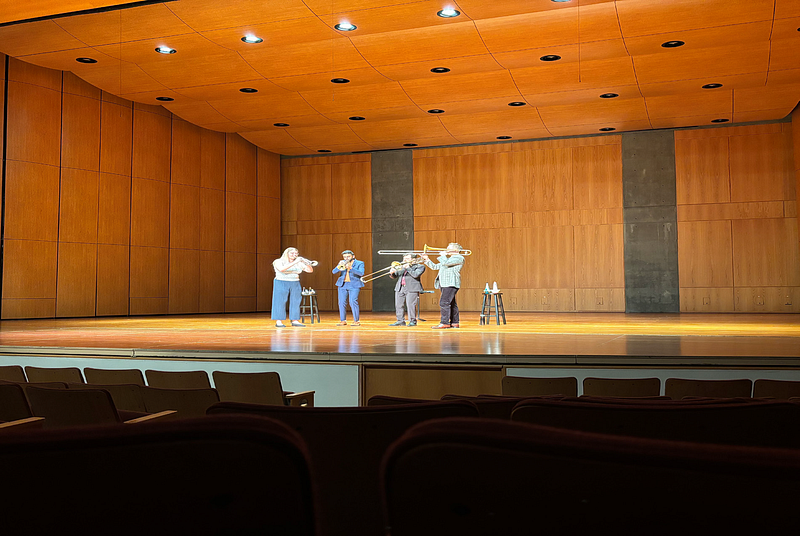by Lucy Leness ’26, A&E Contributor

On Friday, Sept. 27, Hamilton welcomed renowned brass quartet, The Westerlies, to campus. Based in New York, the group consists of Riley Mulherkar and Chloe Rowlands on trumpet, and Andy Clausen and Addison Maye-Saxon on trombone. The New York Times called the group “an arty quartet…mixing ideas from jazz, new classical, and Appalachian folk.” The Westerlies graced a rapt audience in Wellin Hall with eleven songs, three more than promised on the original program.
As they walked on stage, the group immediately launched into their first song, “A Nearer Sun.” An original composition by Mulherkar, the song takes inspiration from the story of Icarus. The slow, sonorous melodies seemed to ripple collectively through each member, as they swayed in time to the music. The quartet flowed easily into their second song, “Fight On,” unleashing a fierce stampede of sound before trombonist Andy Clausen addressed the audience, calling the opportunity to play in a space like Wellin Hall “heavenly.” Though the quartet bounces between genres, Clausen noted their captivation with the tradition of American shape-note music. Later popularized in New England, the shape-note tradition historically referred to a vocal practice of the mid-18th century in England. Shape-note tradition depicts written notes using varying shapes and arose to make learning music easier for singing groups. Much of the quartet’s original compositions take inspiration from aspects of shape-note singing, in addition to the traditional shape-note hymns they play.
Trumpeter Chloe Rowlands composed the group’s next song, “Kerhonkson,” inspired by the town of Kerhonkson, NY, which lies just a few hours south of Clinton. Meant to occur at a walking tempo, “Kerhonkson” highlights the gentleness of the trombone and pluck of the trumpet, somehow jaunty, tranquil and celebratory all at once. The fourth song, “Weeping Mary,” spotlighted a trumpet solo by Mulherkar, before Rowlands and both trombonists joined in to create a perfect harmony of hope and longing. Mulherkar explained that they had heard this song sung by Sam Amidon and instantly knew they wanted to delve deeper into folk and jazz as a quartet. Mulherkar composed their next song, “The Evening Trumpet,” after hearing a hymn called “The Morning Trumpet;” he spoke of the ubiquity of trumpet symbology in hymn, and explained he wanted to create his own take on the hymns he had spent so long learning. Atop a thrumming trombone rhythm, “The Evening Trumpet” deeply exploits the trumpet’s capability for all sorts of sound. The trumpet is high and wistful, deep and growling and as buzzing as a swarm of wasps.
The group continued with a more traditional shape-note song by William Walker, called “Louisiana,” which had actually inspired “Kerhonkson;” Rowlands explained that she essentially flipped this song “upside down” to produce “Kerhonkson.” Another traditional song, called “Parting Friends,” followed, and Clausen then introduced his own composition, “The 5:10 to Ronkonkoma,” intended to celebrate the group’s affinity for public transit. As traveling musicians, the Westerlies often take the 5:10 a.m. Long Island Rail Road train from the Barclays Center in Brooklyn, all the way to Jamaica, Queens. Clausen noted that while this itinerary usually gets them to their 7 a.m. flight from JFK on time, the LIRR occasionally skips Jamaica, and goes express to Ronkonkoma. He asked the audience to consider whether this song ends with the group making their flight, or missing it altogether– personally, despite the shrill crescendo in the middle of the song, I felt like the ringing triumph of the final bars had to signify a successful travel experience!
The quartet continues to explore new pathways of creativity, even taking songs meant for string quartets and adapting them for brass. Brass quartets are a much younger concept than the age-old tradition of string quartets; after hearing “Entr’acte,” composed by Caroline Shaw of the Attacca string quartet in Brooklyn, The Westerlies knew they wanted to adapt the song for brass instruments. The first few bars “fit like a glove,” Mulherkar noted, though the group had to invent various new sounds for string notes that brass simply could not replicate. The Westerlies’ rendition of “Entr’acte” involved the use of mufflers, and their own breath sounds, as if they could beat-box through their trumpets and trombones. Clausen’s composition, “New Berlin, New York,” followed, inspired by a decrepit barn he had visited in the town itself, and the concert ended with “Saro,” a beautiful old English folk song that the band has played since their formation in 2011.
Clausen emerged once more to profusely thank Hamilton “for having us, [and] for providing a stage for the arts and for acoustic music to happen.” The Westerlies’ spectacular performance brought on thunderous applause. Alongside their beautiful songs, they shared with the audience the palpable joy of making music with truly great friends. Their newest album full of shape-note songs will come out in 2025, but be sure to check out their ten current albums and various collaborations (with artists like Fleet Foxes and Big Red Machine), available on a myriad of streaming platforms.
















